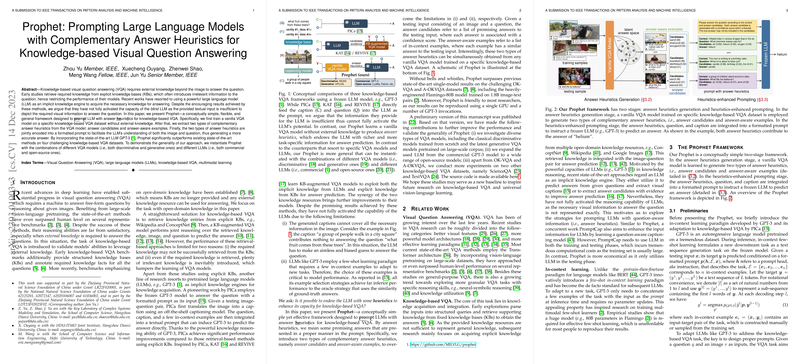A Comprehensive Examination of Prophet: Enhancing Knowledge-Based Visual Question Answering with LLMs
The paper "Prophet: Prompting LLMs with Complementary Answer Heuristics for Knowledge-based Visual Question Answering" presents a novel framework for improving the performance of knowledge-based Visual Question Answering (VQA) by leveraging the inherent capabilities of LLMs. Using Prophet, the researchers aim to overcome the limitations of existing methods that either rely extensively on external knowledge bases (KBs) or do not fully capitalize on the reasoning power of LLMs.
Methodology
The framework consists of two primary stages: Answer Heuristics Generation and Heuristics-enhanced Prompting.
- Answer Heuristics Generation:
- Prophet begins by training a baseline VQA model on a knowledge-based VQA dataset. Notably, this model does not initially incorporate external knowledge, thereby serving as a straightforward, pre-trained baseline.
- From this trained model, Prophet extracts two types of complementary answer heuristics:
- Answer Candidates are a list of potential answers for a given question-image pair, ranked by their associated confidence scores.
- Answer-aware Examples are in-context examples chosen based on the similarity of their answers to the target question.
- By iterating through various discriminative and generative VQA models, such as MCAN (discriminative) and mPLUG (generative), the framework is able to yield diverse heuristics.
- Heuristics-enhanced Prompting:
- This stage involves formatting a prompt that includes the extracted heuristics, which is then fed into an LLM to infer the final answer.
- This integration of multiple knowledge sources in a structured prompt ensures the LLM can produce more accurate predictions by effectively understanding both the context and visual content of the input image-question pair.
Results and Discussion
Prophet's performance was evaluated across several challenging datasets including OK-VQA, A-OKVQA, ScienceQA, and TextVQA, each requiring different types of external domain knowledge. The experiments indicated that Prophet consistently outperforms prior state-of-the-art models across all tasks, especially demonstrating significant improvements over approaches relying on direct multimodal pretraining or simple LLM-based methods like PICa.
A key strength of Prophet lies in its versatility and scalability. It achieves notable performance even when instantiated with different combinations of VQA models and both commercial (e.g., GPT-3) and open-source LLMs (e.g., LLaMA). Importantly, the work highlights that Prophet can adapt to various types of knowledge tasks, thus demonstrating its potential as a flexible, generalizable framework in multimodal learning.
Implications and Future Directions
Prophet underscores the critical role of question-aware information in activating the full potential of LLMs for knowledge-based tasks. By focusing on the fusion of answer heuristics and LLM reasoning, it provides new insights into how LLMs can be leveraged beyond their conventional language processing functions.
However, there remains room for further exploration. For instance, future research could delve into refining the heuristics generation process or optimizing its computational efficiency. Additionally, extending Prophet's capabilities to even larger VQA datasets or integrating it with emerging LLM architectures could yield transformative advances in AI's understanding of multimodal tasks.
Overall, Prophet is a significant contribution to the field of VQA, illustrating how strategically harnessed LLMs, when complemented with well-structured input framing, can significantly enhance AI interpretative and reasoning capabilities, especially in domains reliant on external knowledge.
